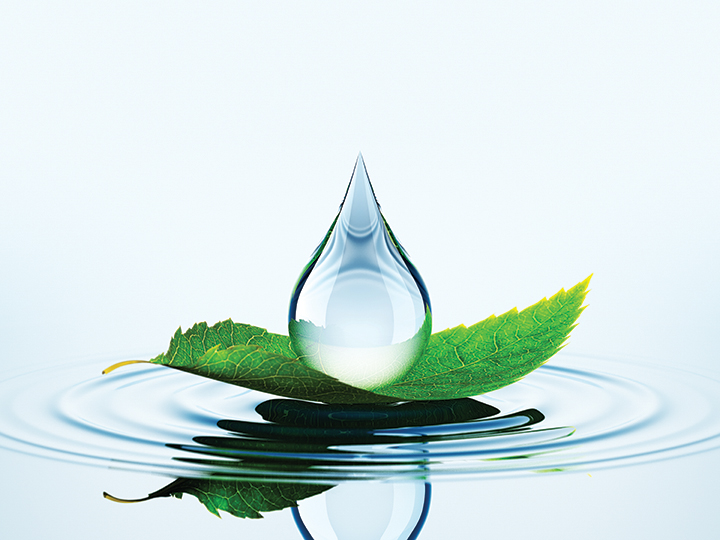
Biodegradable Lubricants – Selection, Application, and Maintenance
December 18, 2018 | By L. (Tex) Leugner

Biodegradable lubricants have become extremely important to support the demands of environmental protection.

Photo: Getty Images.
The description of the two primary classes of biodegradable lubricants, vegetable oil and synthetic categories, have been well documented when compared with traditional mineral oil base lubricants.
However, very little information has been provided by major oil companies or the manufacturers of these biodegradable products with regard to application guidelines and the maintenance of these products once they are in use as machine lubricants.
Industrial users of these products must be prepared to treat biodegradable lubricants somewhat differently than standard mineral base oils. In order to understand these application and maintenance requirements, it is first necessary to review the various types of biodegradable lubricants to point out their advantages and disadvantages.
Vegetable base oils include corn, soybean, canola, sunflower, peanut and olive oils. In their natural form, these oils consist primarily of triglyceride molecular structures and, as such, they have performance limitations; most notably, poor thermal, hydrolytic and oxidation stability.
For example, most natural vegetable oils cannot withstand reservoir temperatures over 80°C (176°F). In addition, water, even in very small amounts of a few hundred parts per million, is the natural enemy of vegetable oils and can cause serious foaming and degradation problems. In general, these oils also exhibit low cold flow abilities.
On the other hand, most of these natural oils have good lubricating qualities due to their polar nature. This provides good metal wetting attraction and also makes them good solvents to keep dirt and debris off metal surfaces. Their molecular structure provides for a natural high viscosity and viscosity index. Genetic modifications have also overcome much of the thermal and oxidative stability problems, particularly with soybean and canola oils.
The use of biodegradable lubricants is desirable for equipment used in certain resource industries, such as forestry, mining, certain oil and gas production, or wherever the lubricants themselves might come into contact with the environment. For example, a perfect application of biodegradable vegetable oil is sawmill chain drive, saw guide and saw blade lubricant, where the oil is “once through” and enters the environment immediately after use. It is also well suited for use in low to medium pressure hydraulic systems or lightly loaded gear drives where operating temperatures do not exceed 71°C (140°F) and where there is little chance of water ingress or high contamination.
Application considerations include the following. Biodegradable lubricants may be very different in their characteristics, and the conversion necessary for their effective use is not quite as simple as draining the used mineral oil and dumping in the new biodegradable lubricant. Before converting to a biodegradable lubricant, consider the lubrication system’s operating and design
characteristics, such as operating temperature, pressures and flow rates, types of sealing or hose materials used, potential for contamination such as water or dust and dirt, and whether or not the quality of the existing filtration system is sufficient for the new fluid.
A most important consideration is whether or not the new biodegradable fluid is compatible with mineral oil. If it is not, serious problems may result if all of the old mineral oil is not thoroughly flushed from the system before the new fluid is installed. Some of the resulting symptoms of a poor or incomplete conversion to biodegradable fluids are severe foaming, leaking seals (particularly
if the seals are of neoprene or nitrile), plugged filters, higher than normal wear on some components (such as the hydraulic pump), and increased operating temperatures.
The next group of biodegradable lubricants includes synthetic types, specifically polyalphaolefins (PAOs), diesters and polyglycols. PAOs are finding increased use as hydraulic and engine oils, particularly in cold climate applications and where hydraulic pressures are increasing, in certain cases up to 7,000 PSI and higher. These oils are also finding selected use as gear lubricants because of
their ability to operate over a wide range of temperatures due to their high viscosity index and lower coefficient of friction, both of which help to reduce wear. These products are generally compatible with mineral oils and, as a result, there is no requirement for extensive flushing before conversion unless required by the manufacturer. PAOs have a negative effect on certain sealing materials causing shrinkage, so initial leakage may be a problem.
Diester biodegradable fluids are excellent lubricants for compressors and turbines. Diester fluids may have a negative effect on certain varnish or paint surfaces because of their exceptional solvency and detergency, so it would be wise to remove the paint from any internal contact surfaces such as the reservoir, as well as thoroughly flush the entire system before conversion.
Polyglycols (PAGs) are often recommended as fire retardant lubricants in addition to their biodegradability, are not compatible with mineral oils, and have some negative effects on certain seal and paint materials. As a result, thorough flushing of the system should be carried out before the conversion.
These products are water soluble, which helps to provide biodegradability but also creates a disadvantage in lubricant applications, because free water contamination tends to occur very quickly.
Since these fluids contain water, they have a greater tendency to hold contaminants in suspension, and, as a result, the filtration systems should be improved in order to ensure bearing surfaces are not unduly introduced to dirt, which has been suspended in the fluid.
Three-micron filters can be used successfully in these systems and are recommended for hydraulic system and pressurized gear reducer applications.
Operating temperatures must be controlled in order to avoid excessive and unnecessary evaporation of these aqueous fluids, and the recommended operating temperature should be kept within a range of about 50°C (122°F) to 60°C (140°F).
Another consideration when using biodegradable water-soluble fluids in a hydraulic application is to pay attention to the pressure relief valves that may be required to remain in the discharge or open position for long periods. This condition can cause cavitation erosion of the valve seat and cause premature failure of the valve, so proper valve selection before conversion should be considered.
Monitoring the condition of biodegradable fluids in service is not any different from that called for with mineral-based hydraulic oil. The most important tests recommended are those that monitor contamination levels by ISO cleanliness standards, water contamination, viscosity changes and total acid number (TAN).
Specifically, the guidelines for these tests are as follows:
1. Contamination testing should be carried out through the use of electronic particle counts that measure the quantity of four, six and 14 micrometer particles in the fluid, respectively, and report the level of contamination by the ISO 4406 cleanliness code.
For example, Vickers hydraulics specifies that in its systems, lubricant cleanliness levels should not exceed 16/13/12, meaning that the level of contaminants of sizes four, six and 14 microns are at an acceptable level. If these levels exceed 16/13/12, the fluid contamination levels are becoming unacceptable.
Water is a natural enemy of all types of lubricants, but biodegradable fluids with a base of vegetable oil are extremely susceptible to degradation caused by water. Moisture and condensation levels should never exceed 500 PPM if long service life is to be achieved.
Even small quantities of water can cause foaming of the fluid and seriously degrade its quality. Water content must be accurately
monitored using the Karl Fischer test technique.
2. The acidity increase should not exceed an AN level of 1.5 mg KOH/gm, depending upon the AN of the new fluid.
3. The viscosity changes (whether an increase or a decrease) should not exceed 10 per cent of the original fluid’s viscosity specification. In addition, viscosity should be measured at both 40°C and 100°C, in order to monitor the viscosity shear rates.
Note: It is important to remember that these standard tests should be carried out on a regularly scheduled basis for any lubricant, whether the fluid is biodegradable, mineral base or synthetic. Most maintenance-oriented users of lubricants monitor their systems at recommended intervals of 350 to 500 hours of operation and, this is sound practice.
